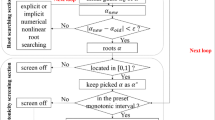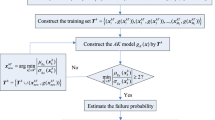Abstract
The ambiguity acceptance test is an important quality control procedure in high precision GNSS data processing. Although the ambiguity acceptance test methods have been extensively investigated, its threshold determine method is still not well understood. Currently, the threshold is determined with the empirical approach or the fixed failure rate (FF-) approach. The empirical approach is simple but lacking in theoretical basis, while the FF-approach is theoretical rigorous but computationally demanding. Hence, the key of the threshold determination problem is how to efficiently determine the threshold in a reasonable way. In this study, a new threshold determination method named threshold function method is proposed to reduce the complexity of the FF-approach. The threshold function method simplifies the FF-approach by a modeling procedure and an approximation procedure. The modeling procedure uses a rational function model to describe the relationship between the FF-difference test threshold and the integer least-squares (ILS) success rate. The approximation procedure replaces the ILS success rate with the easy-to-calculate integer bootstrapping (IB) success rate. Corresponding modeling error and approximation error are analysed with simulation data to avoid nuisance biases and unrealistic stochastic model impact. The results indicate the proposed method can greatly simplify the FF-approach without introducing significant modeling error. The threshold function method makes the fixed failure rate threshold determination method feasible for real-time applications.










Similar content being viewed by others
References
Abidin HZ (1993) Computational and geometrical aspects of on-the-fly ambiguity resolution. Technical Report 164, UNB
De Jonge P, Tiberius C (1996) The LAMBDA method for integer ambiguity estimation: implementation aspects. Technical Report 12, Delft Geodetic Computing Centre
Euler HJ, Goad CC (1991) On optimal filtering of GPS dual frequency observations without using orbit information. J Geod 65(2):130–143
Euler HJ, Schaffrin B (1991) On a measure for the discernibility between different ambiguity solutions in the static-kinematic GPS-mode. In: IAG Symposium, pp 285–295
Feng Y, Wang J (2011) Computed success rates of various carrier phase integer estimation solutions and their comparison with statistical success rates. J Geod 85(2):93–103
Frei E, Beutler G (1990) Rapid static positioning based on the fast ambiguity resolution approach FARA: theory and first results. Manuscr Geod 15(6):325–356
Han S (1997) Quality-control issues relating to instantaneous ambiguity resolution for real-time GPS kinematic positioning. J Geod 71(6):351–361
Hassibi A, Boyd S (1998) Integer parameter estimation in linear models with applications to GPS. IEEE Trans Signal Process 46(11):2938–2952
Landau H, Euler H-J (1992) On-the-fly ambiguity resolution for precise differential positioning. In: Proceedings of ION GPS pp 607–613
Leick A (2004) GPS satellite surveying. Wiley, New York
Marquardt D (1963) An algorithm for least-squares estimation of nonlinear parameters. J Soc Ind Appl Math 11(2):431–441
Odijk D (2002) Weighting ionospheric corrections to improve fast GPS positioning over medium distances. In: Proceedings of the Institute of Navigation 2000 meeting. Delft Technology University
Takasu T, Yasuda A (2010) Kalman-filter-based integer ambiguity resolution strategy for long-baseline rtk with ionosphere and troposphere estimation. ION NTM, pp 161–171
Teunissen PJ (1990) Nonlinear least squares. Manuscr Geod 15(3):137–150
Teunissen PJG (1995) The least-squares ambiguity decorrelation adjustment: a method for fast GPS integer ambiguity estimation. J Geod 70(1):65–82
Teunissen PJG (1998) Success probability of integer GPS ambiguity rounding and bootstrapping. J Geod 72(10):606–612
Teunissen PJG (1999) An optimality property of the integer least-squares estimator. J Geod 73(11):587–593
Teunissen PJG (2002) The parameter distributions of the integer GPS model. J Geod 76(1):41–48
Teunissen PJG (2003a) A carrier phase ambiguity estimator with easy-to-evaluate fail rate. Art Sa 38(3):89–96
Teunissen PJG (2003b) Integer aperture GNSS ambiguity resolution. Art Sa 38(3):79–88
Teunissen PJG (2005) GNSS ambiguity resolution with optimally controlled failure-rate. Art Sa 40(4):219–227
Teunissen PJG, Verhagen S (2009) The GNSS ambiguity ratio-test revisited: a better way of using it. Surv Rev 41(312):138–151
Tiberius C, De Jonge P (1995) Fast positioning using the LAMBDA method. In: Proc. 4th Int Conf Differential satellite systems, Citeseer pp 1–8
Verhagen S (2003) On the approximation of the integer least-squares success rate: which lower or upper bound to use. J GPS 2(2):117–124
Verhagen S (2005) The GNSS integer ambiguities: estimation and validation. Ph.D. thesis, Delft University of Technology
Verhagen S, Li B, Teunissen PJG (2013) Ps-LAMBDA: ambiguity success rate evaluation software for interferometric applications. Comput Geosci 54:361–376
Verhagen S, Teunissen PJG (2006a) New global navigation satellite system ambiguity resolution method compared to existing approaches. J Guid Control Dyn 29(4):981–991
Verhagen S, Teunissen PJG (2006b) On the probability density function of the GNSS ambiguity residuals. GPS Solut 10(1):21–28
Verhagen S, Teunissen PJG (2013) The ratio test for future GNSS ambiguity resolution. GPS Solut 17(4):535–548
Verhagen S, Teunissen PJG, Odijk D (2012) The future of single-frequency integer ambiguity resolution. In: Sneeuw N, Novák P, Crespi M, Sansò F (eds) VII Hotine-Marussi Symposium on Mathematical Geodesy, volume 137 of International Association of Geodesy Symposia, Berlin, Heidelberg. Springer, Berlin Heidelberg
Wang J, Stewart MP, Tsakiri M (1998) A discrimination test procedure for ambiguity resolution on-the-fly. J Geod 72(11):644–653
Wang L, Feng Y (2013) Fixed failure rate ambiguity validation methods for GPS and COMPASS. In: China Satellite Navigation Conference (CSNC) 2013 Proceedings, volume 2. Springer pp 396–415
Wang L, Verhagen S, Feng Y (2014) Ambiguity acceptance testing : a comparison of the ratio test and difference test. In: China Satellite Navigation Conference (CSNC) 2014 Proceedings
Wei M, Schwarz K-P (1995) Fast ambiguity resolution using an integer nonlinear programming method. In: Proceedings of ION GPS pp 1101–1110
Acknowledgments
This work is financially supported by the Australia cooperative research center for spatial information (CRC-SI) project 1.01 New carrier phase processing strategies for achieving precise and reliable multi-satellite, multi-frequency GNSS/RNSS positioning in Australia. Large-scale simulation in this research is supported by QUT High performance computing facilities. Discussions with Prof. Teunissen on the theory of integer aperture estimation and the idea of using a functional description for the threshold values are greatly appreciated.
Author information
Authors and Affiliations
Corresponding author
Rights and permissions
About this article
Cite this article
Wang, L., Verhagen, S. A new ambiguity acceptance test threshold determination method with controllable failure rate. J Geod 89, 361–375 (2015). https://doi.org/10.1007/s00190-014-0780-2
Received:
Accepted:
Published:
Issue Date:
DOI: https://doi.org/10.1007/s00190-014-0780-2




